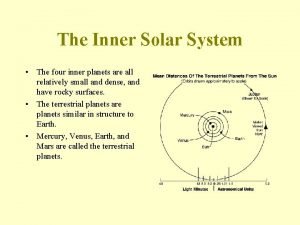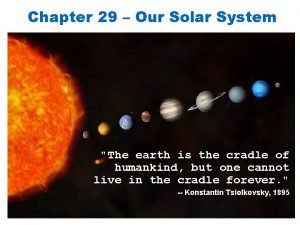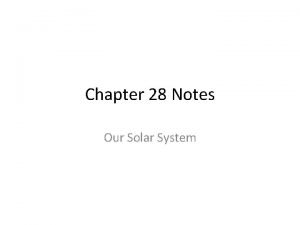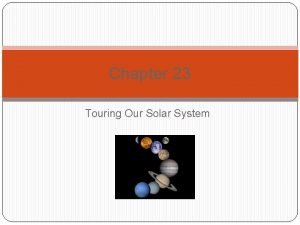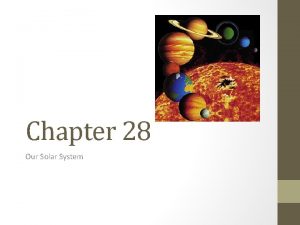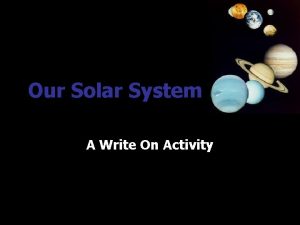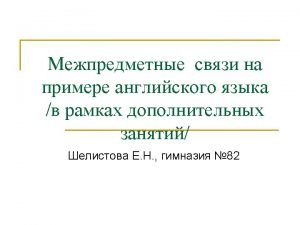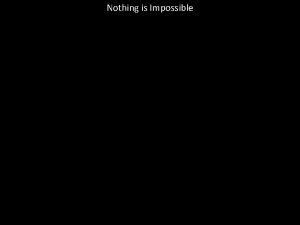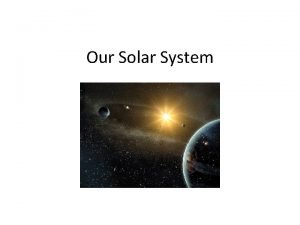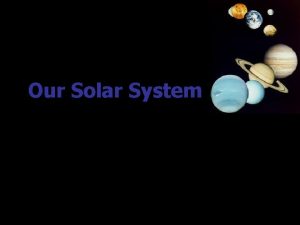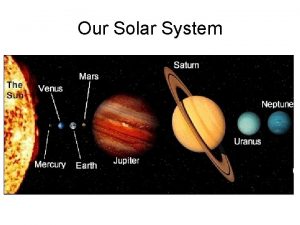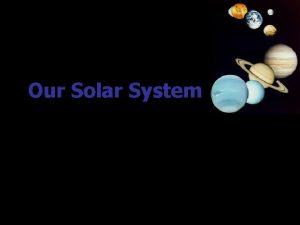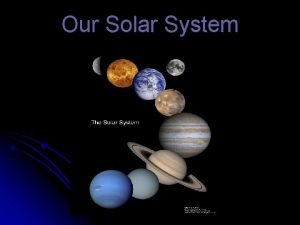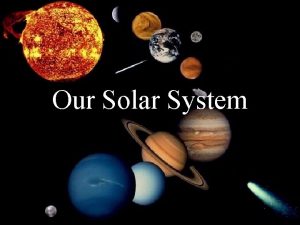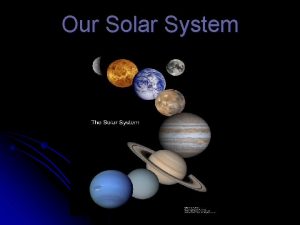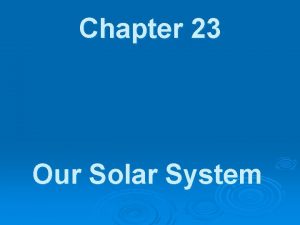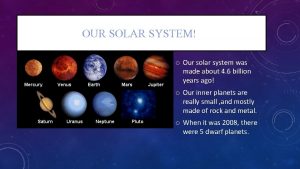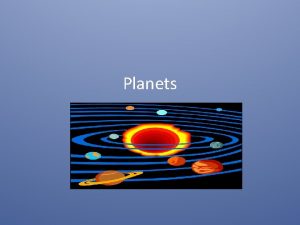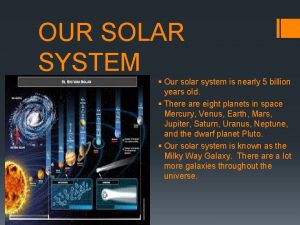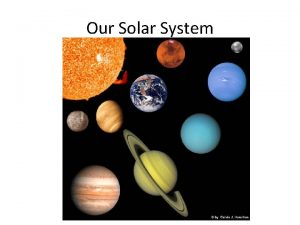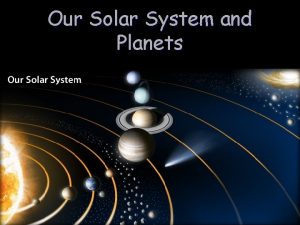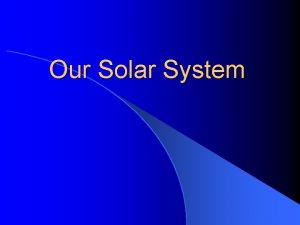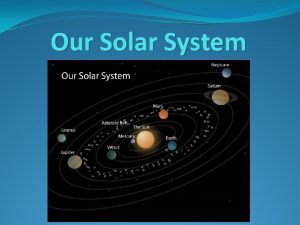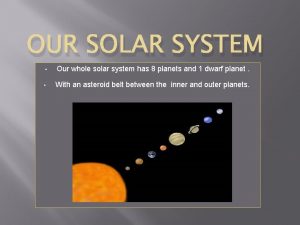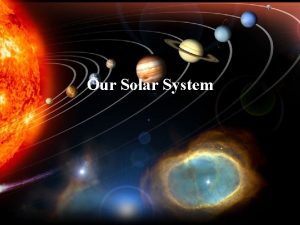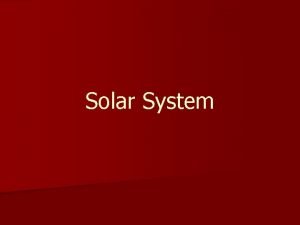Our Solar System Journal Can you name the



























- Slides: 27

Our Solar System

Journal • Can you name the 8 planets in our Solar System? This includes Earth… Mercury, Venus, Earth, Mars, Jupiter, Saturn, Uranus, Neptune

Do you know any ways to remember all 8? • My Very Excellent Mother Just Sold Us Nuggets!

Galaxies • Our sun is 1 of trillions of stars in the universe. Stars are found in groups held together by gravity. • A huge group of stars is called a galaxy. • Our entire universe is made up of thousands of galaxies. • The images below show you how small we are compared to the entire universe. UNIVERSE The entire universe is made of thousands of galaxies GALAXY A huge group of stars held together by gravity. SOLAR SYSTEM A system of planets & stars that are found throughout galaxies

The Milky Way • Our Solar System is part of the “Milky Way” galaxy.

BRAIN POP • GALAXY – http: //www. brainpop. com/science/space/galaxie s/ • MILKY WAY – http: //www. brainpop. com/science/space/milky way/ • SOLAR SYSTEM – http: //www. brainpop. com/science/space/solarsy stem/

The Inner Planets (Terrestrial Planets)

Spinning Planets • Period of Rotation: amount of time that an object takes to rotate once. (1 Day) • Period of Revolution: time it takes an object to revolve around the sun once. (1 year) http: //www. youtube. com/watch? v=97 Ob 0 x R 0 Ut 8&feature=related

Mercury • On Mercury you weigh only 38% of what you weigh on Earth. • Fastest orbiting planet • Planet nearest to the sun • One side of the planet can be 800 degrees Fahrenheit when the other can be -280 degree Fahrenheit at the same time.

Venus • On Venus you weigh only 91% of what you weigh on Earth. • Venus has 90 times the pressure of Earth • Venus has volcanoes like Earth • Rotates in the opposite direction of Earth. • One time there were oceans before they boiled away.

Earth • 23 hours and 56 min=1 Earth day (rotation) • 365 days =1 Earth year (revolution) • Earth is warm enough to keep most of its water from freezing and cold enough to keep it’s water from boiling • Temperature is between – 13 degrees Celsius and 37 degrees Celsius

Mars • Air Pressure on Mars is the same as 30 km above the Earth’s surface • Mars is in the form of ice. • Evidence that water was there at one time • Volcanic history like Earth. • It has the tallest mount of the planets (Olympus Mons) 3 x’s size of Mt. Everest.

Outer Planets (Gas Planets or Jovial Planets)

Jupiter • Largest planet in the Solar System • Has a Great Red Spot from a storm system that is more than 400 years old (It is larger than Earth!) • 9 hours and 54 min=1 Jupiter day (shortest day) • Pressure is so great it would crush a spaceship.

Saturn • 2 nd Largest planet in the Solar System • 95 times more massive than earth. • Saturn has the largest rings of any planet, the rings are made of icy particles. • Most moons of any planet.

Uranus • • Discovered in 1781 Uranus appears blue-green in color It’s axis of rotation is tilted 90 degrees Moons are named after Shakespearean plays and formed from other broken moons.

Neptune • Discovered in 1846 • Neptune has visual belts of clouds • Interior releases thermal energy to its outer layers. • Use to be the 8 th planet after Pluto until 1999.

What Keeps Our Planets & Other Objects In Space In Orbit? ? GRAVITY & INERTIA

GRAVITY & INERTIA • Gravity – A force that pulls all objects toward each other. • Inertia – The tendency of an object to stay either at rest or in motion along a straight path So how does these 2 forces keep everything in orbit? **Example: The picture to the right shows how inertia & gravity work together to keep the moon orbiting the Earth. Actual Orbit

GRAVITY & INERTIA Actual Orbit If inertia was stronger than gravity then objects would stay on their straight path & fly off into space. If gravity was stronger than inertia then objects would crash Inertia & gravity work together to keep the moon orbiting the Earth. And they work together to keep planets orbiting the sun

Other Space Objects COMETS ASTEROIDS METEOROIDS

What is a comet? • A comet is a small body made out of dust, rock, gas & ice. • They are kind of like a dirty snowball • Comets come from faraway regions of our solar system beyond the planets

Comets are made up of different parts. § The nucleus § The coma § The ion tail § The dust tail Comet Brain Pop http: //www. brainpop. com/science/space/comets/

What is an asteroid? • Asteroids are large pieces of space rock with irregular shapes. • They are also known as planetoids or minor planets that revolves around our sun

• Most asteroids orbit the Sun in the asteroid belt located between Mars and Jupiter. A few asteroids approach the Sun more closely. • Asteroids can collide with object such as Earth’s moon, creating huge craters on the surface. Asteroid Brain Pop http: //www. brainpop. com/s cience/space/asteroids/ 3 to 6

METEOROIDS METEORS & METEORITES • • Meteoroids are pieces of rock or dust that are smaller than asteroids. Meteoroids are tiny particles left by an asteroid or a comet & most meteoroids are smaller than the size of a pebble.

• When small meteoroids enters Earth’s atmosphere, they usually burn up & make a fiery trail as it falls, it is then called a meteor or a “shooting star” • Meteors that land on Earth are called meteorites.
 If you think you can you can poem
If you think you can you can poem The four inner planets
The four inner planets Chapter 29 our solar system
Chapter 29 our solar system Chapter 28 our solar system
Chapter 28 our solar system Chapter 23 touring our solar system
Chapter 23 touring our solar system Chapter 28 our solar system
Chapter 28 our solar system Solar system planets
Solar system planets [email protected]
[email protected] Write about our solar system
Write about our solar system If you can imagine it you can achieve it
If you can imagine it you can achieve it Quotes about measurement and improvement
Quotes about measurement and improvement If you can’t measure it, you can’t manage it
If you can’t measure it, you can’t manage it You can t improve what you don t measure
You can t improve what you don t measure Kurzfristiges fremdkapital
Kurzfristiges fremdkapital Wholesale solar panel efficiency
Wholesale solar panel efficiency An inexhaustible source of energy
An inexhaustible source of energy Draw three noncollinear points j k and l
Draw three noncollinear points j k and l Solar system
Solar system Name a board you can write on
Name a board you can write on You can tell harris about it just ____(easily) as i can
You can tell harris about it just ____(easily) as i can You can tell harris about it just ____(easily) as i can.
You can tell harris about it just ____(easily) as i can. Comparative and superlative for less
Comparative and superlative for less Through you blind eyes are open
Through you blind eyes are open Thinking affects our language which then affects our
Thinking affects our language which then affects our Our census our future
Our census our future Christ be our light bernadette farrell
Christ be our light bernadette farrell Marcus aurelius our life is what our thoughts make it
Marcus aurelius our life is what our thoughts make it We bow our hearts we bend our knees
We bow our hearts we bend our knees

